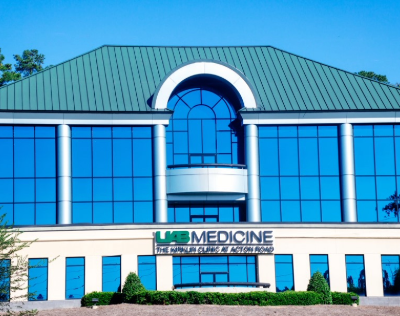 Hazelrig Salter Radiation Oncology Center
Hazelrig Salter Radiation Oncology Center
Two ambulatory clinics in the UAB Department of Radiation Oncology have achieved outstanding results in patient experience. The Office of Patient Experience and Engagement recently reported performance levels from July through September across all UAB ambulatory settings, showing that both Hazelrig-Salter Radiation Oncology Center and the Action Road Radiation Oncology Clinic achieved Level 5 ratings.
“I constantly receive feedback from patients and caregivers about the care and kindness they are shown from our staff,” said Hunter Boggs, M.D., associate professor in the Department of Radiation Oncology. “From therapists to nurses, physicists, M.D.s, administrative assistants, research support, dosimetry, front desk staff, and environmental services, these groups come alongside our patients in their fight against cancer. As a faculty member, I am extremely humbled and grateful to be able to work with each of these groups. I do not think they know how good they actually are. If someone asks me if I would have a member of my family treated here, I tell them that I already have and would do so again without reservation.”
In this system, Level 3 represents meeting the goal, while Levels 4 and 5 reflect performance that exceeds expectations, with Level 5 being the highest level of achievement.
Achieving these ratings is no small feat, according to Andy Clark, operations manager in the Department of Radiation Oncology. It requires teams to perform consistently at a high level throughout the entire year, not just during the measurement quarter.
“You can’t just flip a switch with patient experience and perform like this,” Clark said. “It takes sustained effort, teamwork, and a shared commitment to doing things very well, every single day.”
 The Kirklin Clinic at Acton Road
The Kirklin Clinic at Acton Road
Patient experience is measured using the Net Promoter Score (NPS), a nationally recognized metric that gauges a patient’s likelihood to recommend a clinic to others. The survey question asks patients to rate their likelihood of recommending the clinic on a 0 to 10 scale.
Given how the metric works, earning a score in the 90s is exceptionally challenging, Clark added.
“To do this, it has to be done intentionally where the patient experience is considered in all decisions being made, and there has to be a dedication from the whole team toward excellence,” Clark said. “This also requires a great deal of empathy for your patients and to respond accordingly. In healthcare, this is often difficult to do.”
These achievements highlight more than just impressive scores, they represent the department’s unwavering dedication to compassionate, patient-centered care. From the first point of contact to the final treatment session, every team member plays a vital role in creating a seamless, supportive experience for patients and their families. The recognition of both clinics highlights the department’s collective commitment to upholding the highest standards of excellence in every aspect of care.
“Our patients entrust us with some of the most difficult moments of their lives,” said Corey Speers, M.D., Ph.D., professor and chair, Merle M. Salter, M.D. Endowed Chair of Radiation Oncology. “These results reflect a culture where every member of our team treats that trust as sacred, delivering care that heals not just the body, but the spirit.”